Exploring the Innovation Path of the Digital Construction Industry Using Mixed Methods
Abstract
:1. Introduction
2. Literature Review
2.1. The Concept of the Digital Economy
2.2. Scope of the Digital Economy
2.3. The Concept of Innovation
2.4. Digital Economy Innovation
2.5. Digitalization in the Construction Industry
2.6. Patent Data Research
3. Research Design and Methodology
3.1. Research Subject
3.2. Research Step
- Step 1: Data Collection
- Step 2: Data filtering
- Step 3: Identifying the innovative development path of the digital construction industry
3.3. Mixed Methods Research
3.4. Explanatory Sequence Design
3.5. Social Network Analysis
- (1)
- Modularity
- (2)
- Modularity gain
3.6. Grounded Theory
- (1)
- Generate concepts from the data and log the data step by step;
- (2)
- Continually compare data and concepts and systematically ask generative theoretical questions about the concepts;
- (3)
- Develop theoretical concepts and establish connections between them;
- (4)
- Encode the data level by level (encoding data is the most important part of grounded theory, which includes three levels of coding); and
- (5)
- Construct theories that strive to obtain the density, variability and high degree of integration of the theoretical concepts.
4. Results and Discussions
4.1. Characteristics of Innovation Networks in the Digital Construction Industry
- (1)
- The network scale had a gradual expansion tendency. The number of nodes and edges in the network both increased annually, which means that cooperation among subjects in various fields was gradually expanding.
- (2)
- The network diameter increased every year, reaching 16 in 2020. Research has shown that the diameter of sci-tech innovation networks increases rapidly at the beginning of their growth [48]. The growth trend of the innovation network of the 9 cities in the Bay Area shows that these cities had entered their growth period.
- (3)
- Compared with the number of nodes, the average path length of all clusters was very small, and the average clustering coefficient was always greater than 0.8, which are the characteristics of a small world network.
- (4)
- The average degree and average weighted degree of the network nodes showed an increasing annual trend, indicating that the connectivity of the network also increased every year. However, the network density was much lower than 1, indicating that although the innovation subjects increased each year, they were all in small independent and modularized networks, and the overall cohesion of the network was not strong, representing unstable and weak cooperation among various fields.
4.2. Subject Identification in Innovation Network Research on the Digital Construction Industry
4.3. Evolution of the Innovation Network in the Digital Construction Industry
- (1)
- Evolution of innovation themes in the digital construction industry
- (2)
- Evolution of key technologies for innovation in the digital construction industry
4.4. Qualitative Research on the Digital Construction Industry
- (1)
- Open coding
- (2)
- Axial coding
- (3)
- Selective coding
5. Conclusions
Author Contributions
Funding
Institutional Review Board Statement
Informed Consent Statement
Data Availability Statement
Conflicts of Interest
References
- Teisserenc, B.; Sepasgozar, S. Adoption of Blockchain Technology through Digital Twins in the Construction Industry 4.0: A PESTELS Approach. Buildings 2021, 11, 670. [Google Scholar] [CrossRef]
- Calvetti, D.; Mêda, P.; Chichorro Gonçalves, M.; Sousa, H. Worker 4.0: The Future of Sensored Construction Sites. Buildings 2020, 10, 169. [Google Scholar] [CrossRef]
- Li, L.; Chen, J.; Su, X.; Nawaz, A. Advanced-Technological UAVs-Based Enhanced Reconstruction of Edges for Building Models. Buildings 2022, 12, 1248. [Google Scholar] [CrossRef]
- China Academy of Information and Communications Technology. White Paper on China’s Digital Economy Development; China Academy of Information and Communications Technology: Beijing, China, 2022. (In Chinese) [Google Scholar]
- Zhuang, T.; Wu, H. Research on the three-helix measure of government-industry-university-research Institute based on patent data. Manag. World 2013, 8, 175–176. (In Chinese) [Google Scholar]
- Li, X.B. An empirical analysis on the change of regional innovation capability in China: From the perspective of innovation system. Manag. World 2007, 12, 18–30. (In Chinese) [Google Scholar]
- Tapscott, D. The digital economy: Promise and peril in the age of networked intelligence. Educom. Rev. 1996, 31, 52. [Google Scholar]
- G20. G20 Digital Economy Development and Cooperation Initiative; G20 Research Group at the University of Toronto: Toronto, Canada, 2016. [Google Scholar]
- China Academy of Information and Communications Technology. White Paper on China’s Digital Economy Development; China Academy of Information and Communications Technology: Beijing, China, 2017. (In Chinese) [Google Scholar]
- Buckley, P.; Montes, S.; Henry, D. Digital economy 2000. In Economics and Statistics Administration Office of Policy Development; US Department of Commerce: Washington, DC, USA, 2000. [Google Scholar]
- United States Department of Commerce. The Emerging Digital Economy; US Department of Commerce: Washington, DC, USA, 1998. [Google Scholar]
- Mesenbourg, T.L. Measuring the Digital Economy. US Bur. Census 2001, 1, 1–19. [Google Scholar]
- U.S. Bureau of Economic Analysis. Highlights and Challenges of Measuring the Digital Economy; Bureau of Economic Analysis Publishing: Washington, DC, USA, 2017. [Google Scholar]
- Xu, X.C.; Zhang, M.H. Review on measurement of value added of the digital economy. China J. Econom. 2022, 2, 19–31. (In Chinese) [Google Scholar]
- Su, Z.; Xu, S.D. An evaluation of chinese technological progress and the convergence of economic growth—From the perspective of innovation and efficiency. Soc. Sci. China 2015, 7, 4–25. (In Chinese) [Google Scholar]
- Schumpeter, J.A. The Theory of Economic Development: An Inquiry into Profits, Capital, Credit, Interest and the Business Cycle; Original work published; Harvard University Press: Cambridge, MA, USA, 1934. [Google Scholar]
- Drucker, P.F. Innovation and Entrepreneurship; Routledge Publishing: London, UK, 2014. [Google Scholar]
- Freeman, C.; Soete, L. The Economics of Industrial Innovation; Routledge Publishing: London, UK, 1997. [Google Scholar]
- Acs, Z.J.; Anselin, L.; Varga, A. Patents and innovation counts as measures of regional production of new knowledge. Res. Policy 2002, 31, 1069–1085. [Google Scholar] [CrossRef]
- Gregory, V. Understanding digital transformation: A review and a research agenda. J. Strateg. Inf. Syst. 2019, 28, 118–144. [Google Scholar]
- Satish, N.; Mike, W.; Maryann, F. The digital transformation of innovation and entrepreneurship: Progress, challenges and key themes. Res. Policy 2019, 48, 103773.1–103773.9. [Google Scholar]
- Zhu, H.L.; Wang, C.J. Industry digital transformation under the background of “double-cycle” new development pattern strategy: Theory and countermeasure. Financ. Trade Econ. 2021, 42, 14–27. (In Chinese) [Google Scholar]
- Xie, K.; Wu, Y.; Xiao, J.H. Mode of production digital transformation and adaptive innovation—The innovation logic of digital economy. J. Beijing Jiaotong Univ. 2021, 20, 1–10. (In Chinese) [Google Scholar]
- Dong, Z.M. Policy-driven innovation-driven structure optimization: The system construction of digital publishing industry since the 18 th national congress of CPC. China Publ. J. 2017, 17, 11–15. (In Chinese) [Google Scholar]
- Du, Z.H. The relationship between open government data and innovation-driven economic growth. J. Cap. Norm. Univ. 2020, 2, 63–71. (In Chinese) [Google Scholar]
- Liu, S.C. The target path and policy supply of high-quality development of Chinese digital economy. Economist 2019, 6, 52–61. (In Chinese) [Google Scholar]
- He, H.Q. Digital Finance: An important driver of high-quality economic development. J. Xi’an Inst. Financ. Econ. 2019, 32, 45–51. (In Chinese) [Google Scholar]
- Xue, Y.; Hu, J. Financial technology promotes high-quality economic development: Theoretical logic, practical basis and path choice. Reform 2020, 3, 53–62. (In Chinese) [Google Scholar]
- Cao, Z.Y. Research on the new manufacturing mode of promoting high-quality development of Chinese industry under the background of digital economy. Theor. Investig. 2018, 2, 99–104. (In Chinese) [Google Scholar]
- Wang, W.L.; Wang, J. Research on the development trend and promotion policy of digital economy in China. Econ. Rev. J. 2019, 1, 69–75. (In Chinese) [Google Scholar]
- Zhao, J.B.; Yang, D.H. We will accelerate innovation and standardized development of the digital economy. J. Beijing Univ. Technol. 2019, 19, 71–79. (In Chinese) [Google Scholar]
- Chen, X.H.; Tang, L.X.; Li, Y.J.; Huo, B.F.; Liu, S.X.; Gu, Y.D.; Zhang, X.W.; Wu, G. The theory and demonstration of enterprise operation and service innovation management in the digital economy era. Bull. Natl. Nat. Sci. Found. China 2019, 33, 301–307. (In Chinese) [Google Scholar]
- Puolitaival, T.; Kähkönen, K. Individual Competence Requirements for Digital Technologies in Construction Management. New Zealand Built Environ. Res. Symp. 2020, 6, 262–266. [Google Scholar]
- Wang, K.; Guo, F.; Zhang, C.; Schaefer, D. From Industry 4.0 to Construction 4.0: Barriers to the digital transformation of engineering and construction sectors. Eng. Constr. Archit. Manag. 2022. ahead-of-print. [Google Scholar] [CrossRef]
- Khahro, S.H.; Hassan, S.; Zainun, N.Y.B.; Javed, Y. Digital Transformation and E-Commerce in Construction Industry: A Prospective Assessment. Acad. Strateg. Manag. J. 2021, 1, 1–8. [Google Scholar]
- Hall, B.H.; Jaffe, A.B.; Trajtenberg, M. The NBER Patent Citation Data File: Lessons, Insights and Methodological Tools; Social Science Electronic Publishing: Rochester, NY, USA, 2001. [Google Scholar]
- Zhang, M.Q.; Deng, M.M. Research on the Characteristics of International Patent Cooperation between China and Countries Alongside One Belt and One Road Area. J. Intell. 2016, 35, 37–42. (In Chinese) [Google Scholar]
- Zhang, Y.M.; Li, K. Research on the spatial distribution and dependence of chinese innovative output: Spatial econometrics analysis based on province-level patent data. China Soft Sci. 2007, 11, 97–103. (In Chinese) [Google Scholar]
- Li, W.J.; Zheng, M.N. Is it Substantive Innovation or Strategic Innovation?—Impact of Macroeconomic Policies on Micro-enterprises’ Innovation. Econ. Res. J. 2016, 51, 60–73. (In Chinese) [Google Scholar]
- Zhu, P.F.; Xu, W.M. On The Impact of Government’s S&T Incentive Policy on the R&D input and its patent output of large and medium-sized Industrial enterprises in Shanghai. Econ. Res. J. 2003, 6, 45–53. (In Chinese) [Google Scholar]
- Chen, A.; Liu, X.L.; Cheng, P. Empirical Test of the Spatial Diffusion Process of Knowledge Spill—Off—Take the Diffusion Process of a Kind of Granted Patent as a Clue. Sci. Sci. Manag. S.T. 2010, 31, 96–101. (In Chinese) [Google Scholar]
- Ernst, H. Patent information for strategic technology management. World Pat. Inf. 2003, 25, 233–242. [Google Scholar] [CrossRef]
- China Academy of Information and Communications Technology. The Report on the Development and Employment of the Digital Economy in the Guangdong-Hong Kong-Macao Bay Area; CAICT: Guangzhou, China, 2020. (In Chinese) [Google Scholar]
- Johnson, R.B.; Onwuegbuzie, A.J. Mixed Methods Research:A Research Paradigm Whose Time Has Come. Educ. Res. 2004, 33, 14–26. [Google Scholar] [CrossRef] [Green Version]
- Tashakkori, A.; Creswell, J.W. The New Era of Mixed Methods. J. Mix. Methods Res. 2007, 1, 4. [Google Scholar] [CrossRef]
- Glaser, B.G.; Strauss, A.L. The Discovery of Grounded Theory:Strategies for Qualitative Research; Aldine: Chicago, IL, USA, 1967. [Google Scholar]
- Strauss, A. Qualitative Analysis for Social Scientists; Cambridge University Press: Cambridge, UK, 1987. [Google Scholar]
- Bettencourt, L.M.A.; Kaiser, D.I.; Kaur, J. Scientific discovery and topological transitions in collaboration networks. J. Informetr. 2009, 3, 210–221. [Google Scholar] [CrossRef]



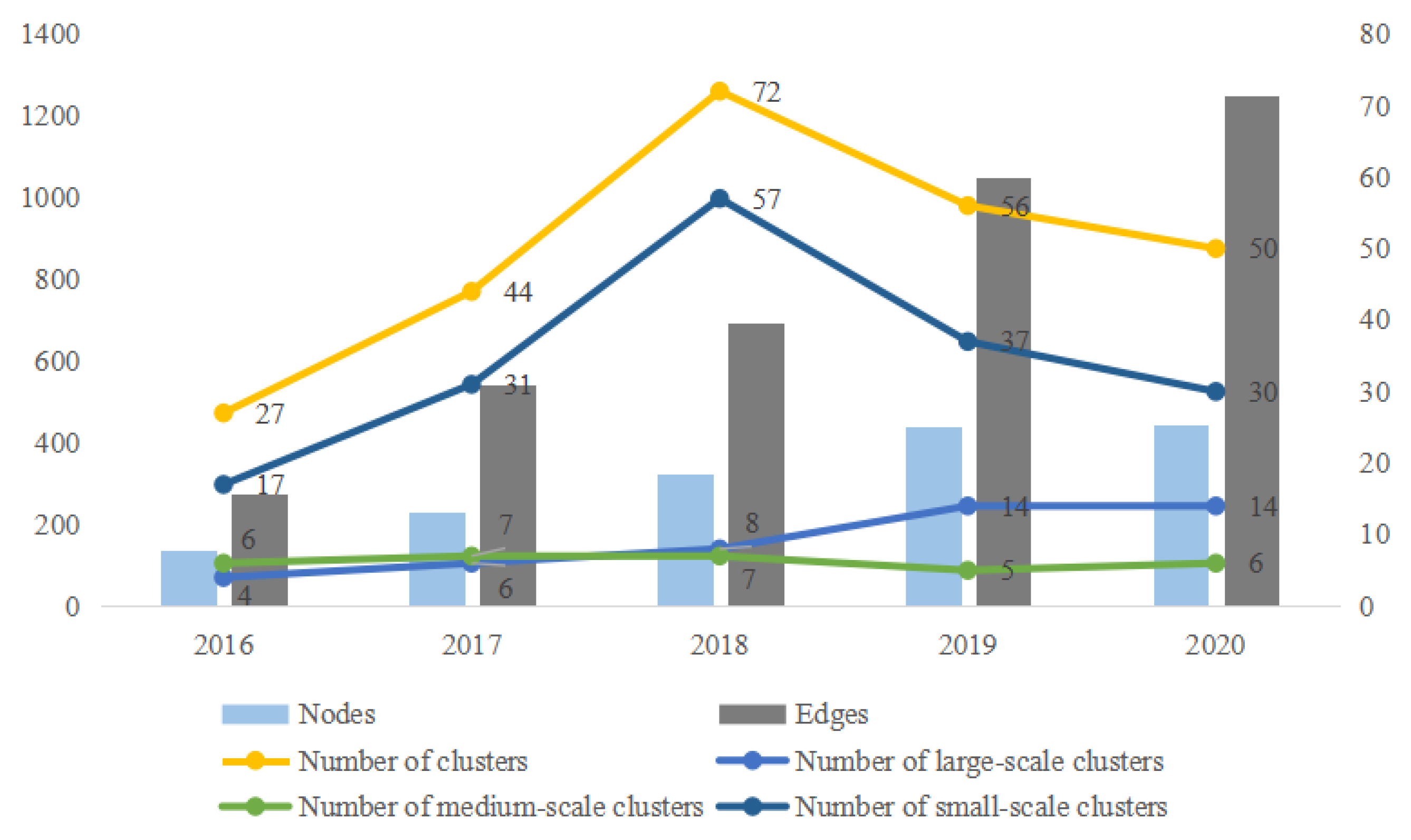
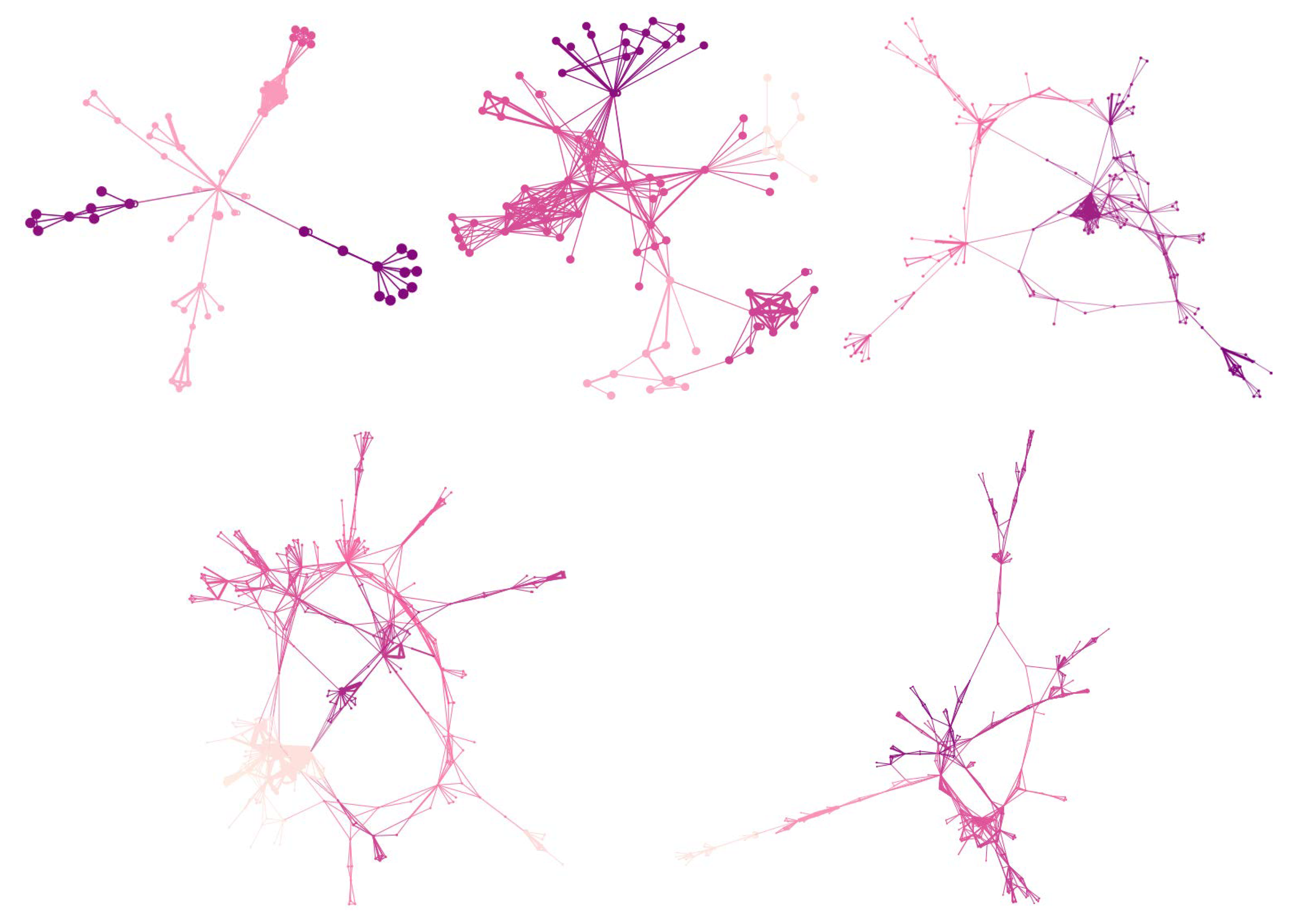


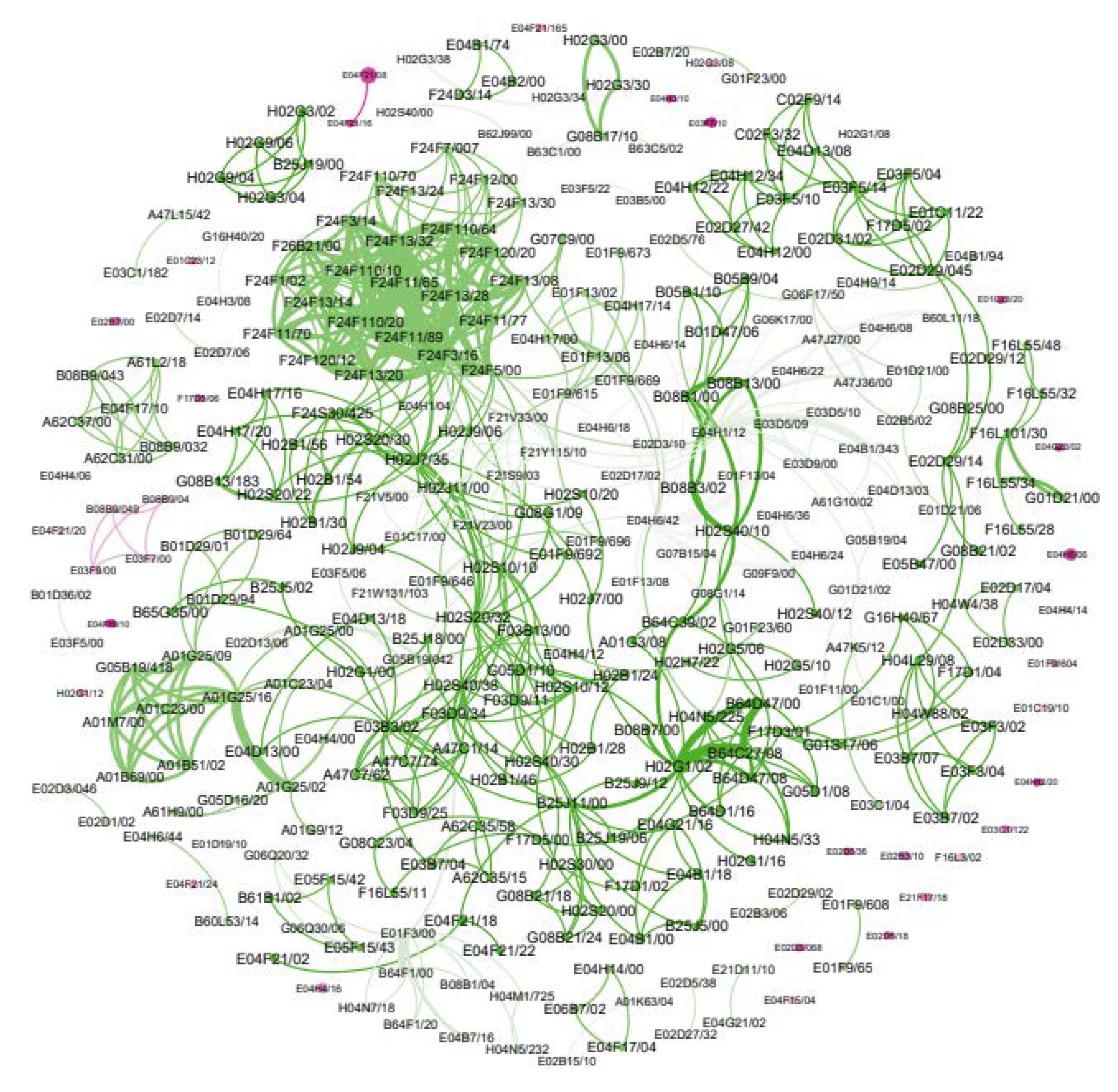
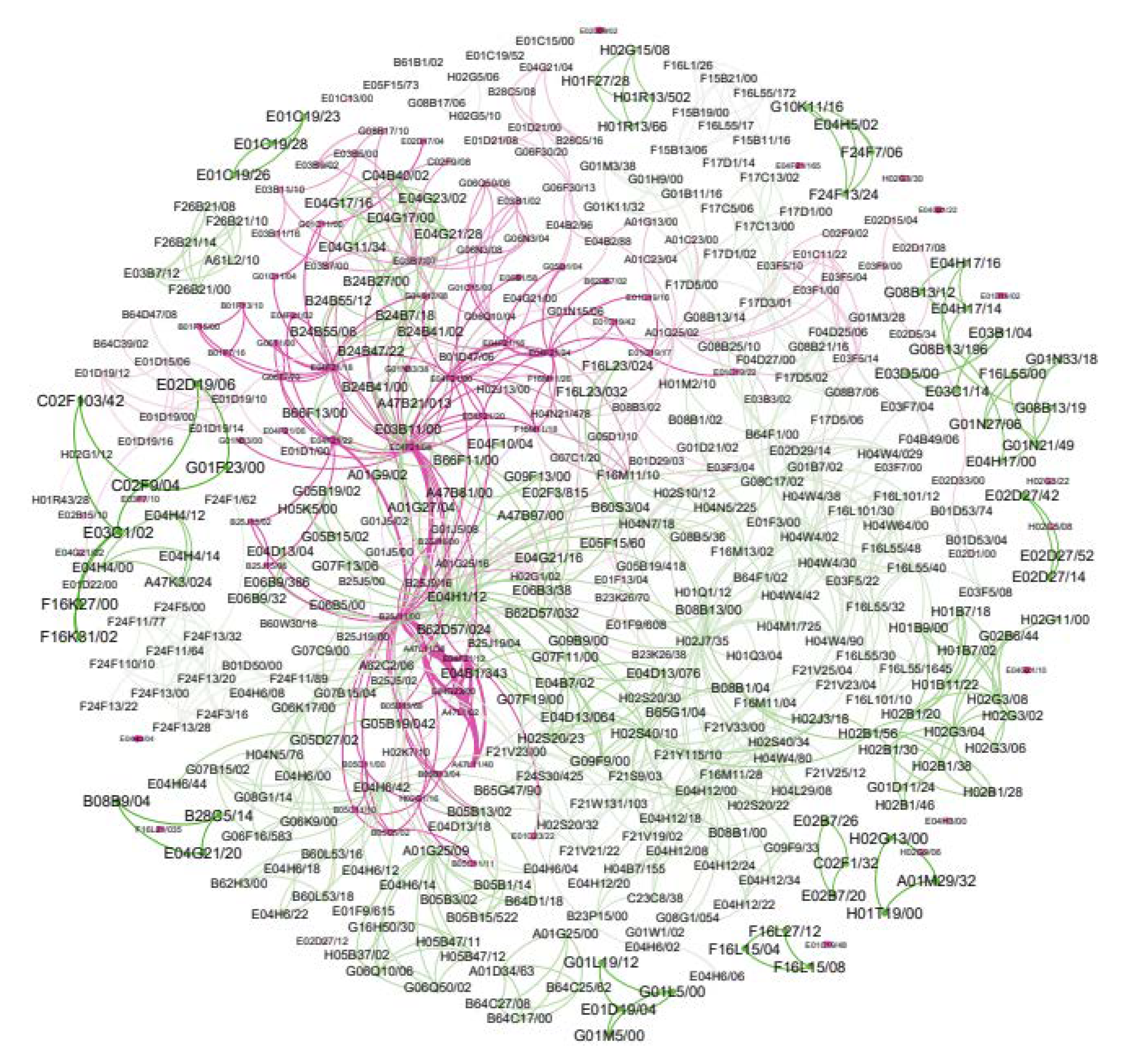
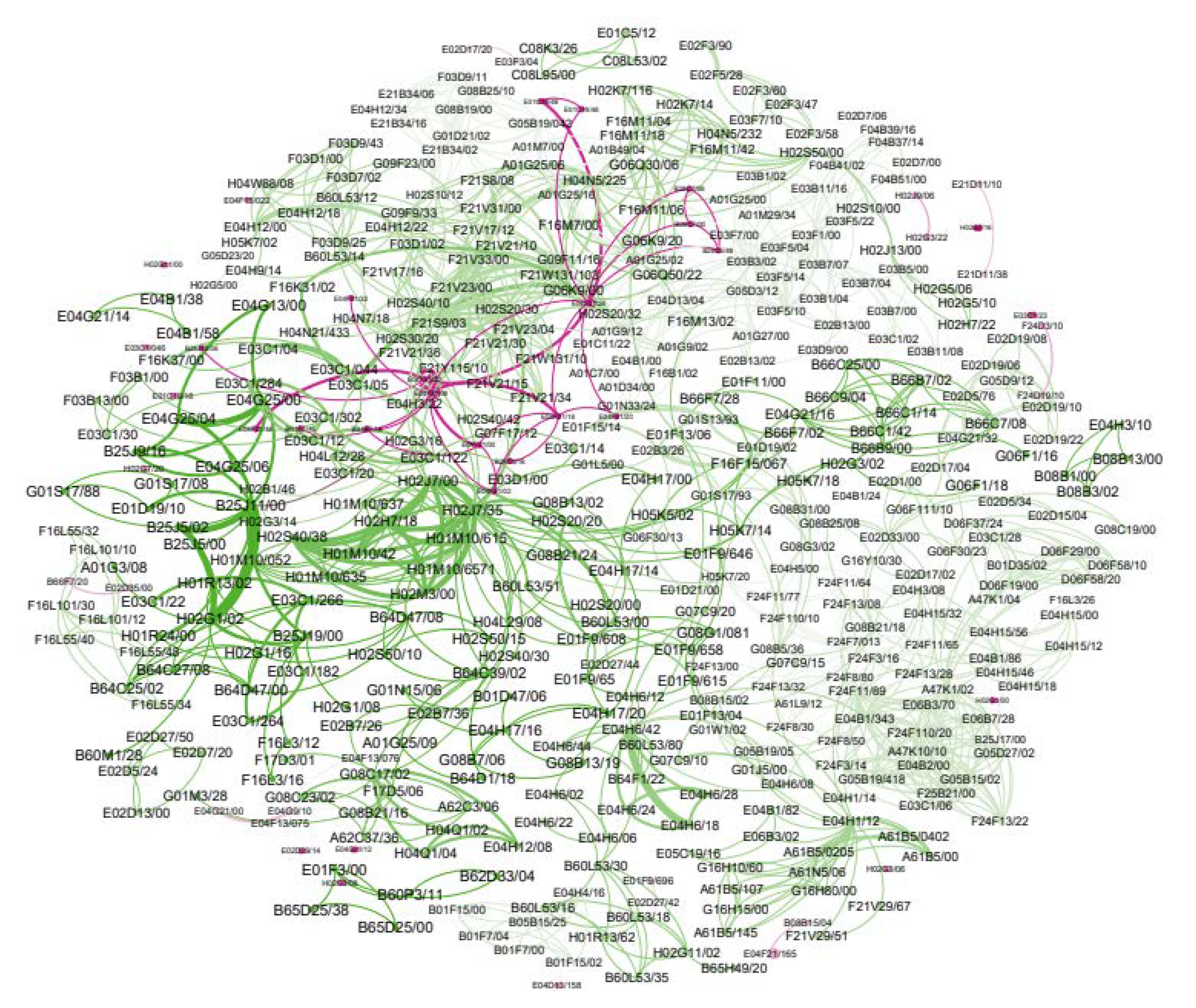
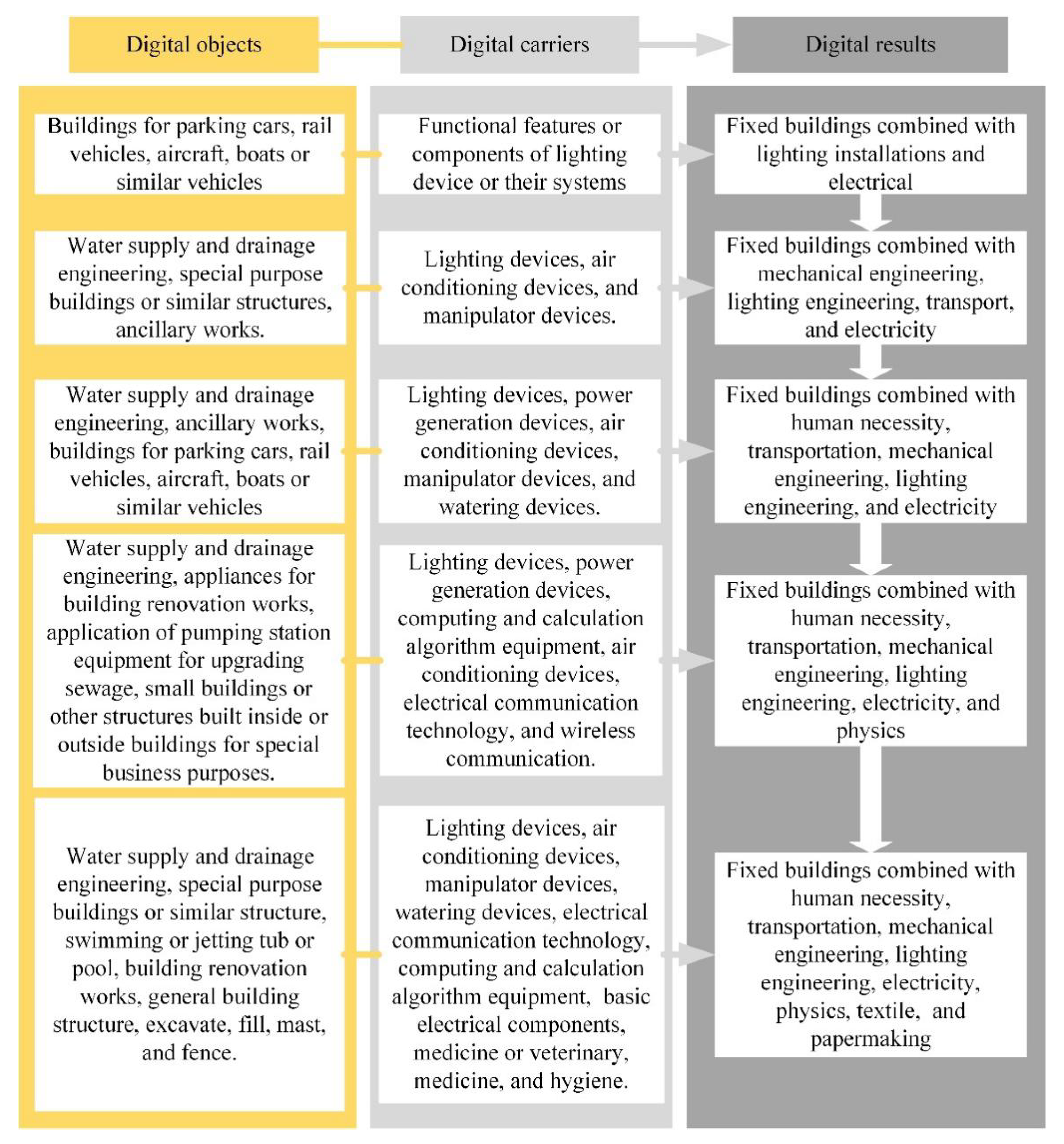


| Year | Node | Edge | Average Degree | Average Weighting | Network Diameter | Network Density | Average Clustering Coefficient | Average Path Length |
|---|---|---|---|---|---|---|---|---|
| 2016 | 135 | 274 | 4.059 | 4.296 | 6 | 0.03 | 0.855 | 3.609 |
| 2017 | 232 | 544 | 4.69 | 5.629 | 9 | 0.02 | 0.885 | 3.395 |
| 2018 | 325 | 695 | 4.277 | 5.902 | 11 | 0.013 | 0.839 | 4.708 |
| 2019 | 442 | 1048 | 4.742 | 6.937 | 12 | 0.011 | 0.831 | 5.072 |
| 2020 | 446 | 1249 | 5.601 | 6.534 | 16 | 0.013 | 0.857 | 6.206 |
| Patent Description | Initial Category |
|---|---|
| Integrated construction robot for high-rise buildings | Intelligent building robot |
| Intelligent monitoring system for scenery complementation | Intelligent monitoring system |
| New energy haze removal and environmental protection lighting device based on the Internet of Things | Intelligent lighting device |
| ...... | ...... |
| Lead rubber bearing, intelligent bearing and bearing monitoring system | Intelligent monitoring system |
| Height detection system for the concrete pouring surface of superdeep pile holes | Intelligent detection system |
| Antistatic ventilation floor | Intelligent building materials |
| ...... | ...... |
| Intelligent firefighting integrated cover plate and integrated monitoring and fire-extinguishing system | Intelligent fire system |
| Intelligent integrated irrigation system | Intelligent irrigation equipment |
| Parking space lock, positioning base station and intelligent parking space lock system | Intelligent transportation equipment |
| ...... | ...... |
| Intelligent robot for building urban municipal green belts | Intelligent building robot |
| Box structure of an internet intelligent mini recording room | Intelligent building device |
| Cleaning robot for attached submarine tunnels | Robot cleaning |
| Subcategory | Principal Category |
|---|---|
| Buildings, transportation | Construction industry |
| Intelligent building materials and intelligent materials for decoration | Construction materials |
| Computer control, temperature control equipment, and intelligent control equipment | Digital control equipment |
| Intelligent induction device, intelligent indicating device, and intelligent sensing equipment | Digital sensing equipment |
| Intelligent monitoring system, intelligent identification system, intelligent detection system, temperature monitoring equipment, temperature detection device, and intelligent flaw detection equipment | Digital monitoring equipment |
| Intelligent building robot, construction robot, working robot, inspection robot, detection robot, and robot cleaning | Digital construction robots |
| Unmanned aerial vehicle cleaning, unmanned aerial vehicle installation, and unmanned aerial vehicle detection | Digital construction UAV |
| Intelligent lighting device, intelligent fire system, intelligent irrigation equipment, intelligent connection equipment, intelligent air purification device, communication facilities, intelligent support equipment, and intelligent charging system | Digital building accessories |
| Intelligent buildings, intelligent transportation, and construction of intelligent buildings | Digital construction industry |
| Intelligent building equipment, intelligent building device, intelligent building machine, intelligent parking equipment, and intelligent transportation equipment | Digital construction equipment |
Publisher’s Note: MDPI stays neutral with regard to jurisdictional claims in published maps and institutional affiliations. |
© 2022 by the authors. Licensee MDPI, Basel, Switzerland. This article is an open access article distributed under the terms and conditions of the Creative Commons Attribution (CC BY) license (https://creativecommons.org/licenses/by/4.0/).
Share and Cite
Xue, X.; Tan, X.; Huang, Q.; Zhu, H.; Chen, J. Exploring the Innovation Path of the Digital Construction Industry Using Mixed Methods. Buildings 2022, 12, 1840. https://doi.org/10.3390/buildings12111840
Xue X, Tan X, Huang Q, Zhu H, Chen J. Exploring the Innovation Path of the Digital Construction Industry Using Mixed Methods. Buildings. 2022; 12(11):1840. https://doi.org/10.3390/buildings12111840
Chicago/Turabian StyleXue, Xiaolong, Xianyu Tan, Qiongyu Huang, Hui Zhu, and Jianshuo Chen. 2022. "Exploring the Innovation Path of the Digital Construction Industry Using Mixed Methods" Buildings 12, no. 11: 1840. https://doi.org/10.3390/buildings12111840




